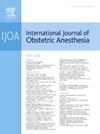剖腹产时胎儿头部受撞击的麻醉注意事项:重点回顾
IF 2.3
3区 医学
Q2 ANESTHESIOLOGY
引用次数: 0
摘要
背景胎头撞击是指胎头深陷母体骨盆,在剖腹产时难以娩出。为了娩出胎头,需要额外的手术操作和/或药物溶胎。本重点综述旨在从麻醉师的角度概述这种产科急症的发生率、风险因素、处理方法和并发症。结果据估计,在任何宫颈扩张的情况下,1.5%的择期剖宫产和2.9-18.4%的紧急剖宫产会发生胎头撞击。风险因素包括宫颈扩张过大、使用催产素催产、第二产程延长、胎位不正以及手术产科医生级别较低。如果发生胎头撞击,麻醉师应与多学科团队合作,考虑降低手术台的高度,提供一个台阶供产科医生站立,让患者头朝下,使用三硝酸甘油酯(或硝酸甘油)、β-2 肾上腺素受体激动剂或挥发性麻醉剂进行药物催产,并处理产后出血等并发症。结论胎儿头部受撞击是产科急症,麻醉师应熟悉并在处理中发挥重要作用。我们提出了一种处理算法,可作为临床决策辅助工具。本文章由计算机程序翻译,如有差异,请以英文原文为准。
Anaesthetic considerations for impacted fetal head at caesarean delivery: a focused review
Background
Impacted fetal head occurs when the fetal head is deeply engaged within the maternal pelvis and difficult to deliver during caesarean delivery. In order to deliver the fetal head, additional surgical manoeuvres and/or pharmacological tocolysis are needed. The aim of this focused review is to outline the incidence, risk factors, management and complications of this obstetric emergency from the perspective of the anaesthetist.
Methods
Databases were searched for free text headings and subject headings associated with different permutations of terms related to impacted fetal head and caesarean delivery.
Results
Impacted fetal head has been estimated to occur in 1.5 % of elective caesarean deliveries and 2.9–18.4% of all emergency caesarean deliveries at any cervical dilatation. Risk factors include advanced cervical dilatation, labour augmentation with oxytocin, prolonged second stage of labour, fetal malposition and junior grade of operating obstetrician. If impacted fetal head occurs, the anaesthetist in conjunction with the multidisciplinary team should consider decreasing the height of the operating table, providing a step for the obstetrician to stand on, placing the patient in the head down position, providing pharmacological tocolysis with glyceryl trinitrate (or nitroglycerin), beta-2 adrenoreceptor agonists or volatile anaesthetic agents, and managing complications such as postpartum haemorrhage.
Conclusion
Impacted fetal head is an obstetric emergency that the anaesthetist should be familiar with and has a vital role in managing. We propose an algorithm for management that may serve as a clinical decision aid.
求助全文
通过发布文献求助,成功后即可免费获取论文全文。
去求助
来源期刊
CiteScore
4.70
自引率
7.10%
发文量
285
审稿时长
58 days
期刊介绍:
The International Journal of Obstetric Anesthesia is the only journal publishing original articles devoted exclusively to obstetric anesthesia and bringing together all three of its principal components; anesthesia care for operative delivery and the perioperative period, pain relief in labour and care of the critically ill obstetric patient.
• Original research (both clinical and laboratory), short reports and case reports will be considered.
• The journal also publishes invited review articles and debates on topical and controversial subjects in the area of obstetric anesthesia.
• Articles on related topics such as perinatal physiology and pharmacology and all subjects of importance to obstetric anaesthetists/anesthesiologists are also welcome.
The journal is peer-reviewed by international experts. Scholarship is stressed to include the focus on discovery, application of knowledge across fields, and informing the medical community. Through the peer-review process, we hope to attest to the quality of scholarships and guide the Journal to extend and transform knowledge in this important and expanding area.

 求助内容:
求助内容: 应助结果提醒方式:
应助结果提醒方式:


